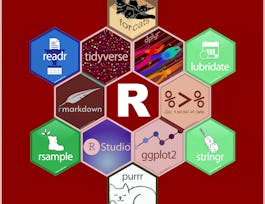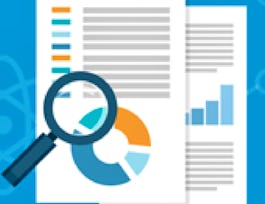When working in the data science field you will definitely become acquainted with the R language and the role it plays in data analysis. This course introduces you to the basics of the R language such as data types, techniques for manipulation, and how to implement fundamental programming tasks.



Introduction to R Programming for Data Science
This course is part of multiple programs.

Instructor: Yan Luo
Sponsored by Barbados NTI
49,021 already enrolled
(533 reviews)
What you'll learn
Manipulate primitive data types in the R programming language using RStudio or Jupyter Notebooks.
Control program flow with conditions and loops, write functions, perform character string operations, write regular expressions, handle errors.
Construct and manipulate R data structures, including vectors, factors, lists, and data frames.
Read, write, and save data files and scrape web pages using R.
Skills you'll gain
Details to know

Add to your LinkedIn profile
1 quiz, 8 assignments
See how employees at top companies are mastering in-demand skills

Build your subject-matter expertise
- Learn new concepts from industry experts
- Gain a foundational understanding of a subject or tool
- Develop job-relevant skills with hands-on projects
- Earn a shareable career certificate


Earn a career certificate
Add this credential to your LinkedIn profile, resume, or CV
Share it on social media and in your performance review

There are 5 modules in this course
Regardless of the programming language you use, all share some commonalities. For example, you’ll likely need to perform basic operations on different data types, like applying mathematical equations to numeric data. You’ll also need an environment in which to write your code, anbbd most modern integrated development environments (or IDEs) provide features that make writing code easier, like syntax checking, color coding, and integrated help. This module introduces you to the R language, its common data types, and techniques for manipulating them. You’ll also learn about the role of the R interpreter and how it transforms code into executable objects. Finally, you’ll be introduced to two of the most common IDEs for R development: RStudio and Jupyter Notebook.
What's included
7 videos1 reading1 quiz1 assignment2 app items
The R language supports many types of data structures that you can use to organize and store values in your code, including vectors, factors, lists, arrays, matrices, and data frames. Each data structure type serves a specific purpose and can contain specific kinds of data. So, it’s important to understand the differences between them so you can make the right choice based on your scenario. In this module, you’ll learn about the types of data you can store in each data structure and how to add, remove, or manipulate its contents.
What's included
5 videos1 reading2 assignments3 app items
As with most programming languages, R supports coding features that you can use to control the flow of program execution, define functions that can perform specific tasks, work with common data types, like strings and dates, and make your code more robust by intercepting likely errors and handling them before they interrupt the execution of your code. In this module, you’ll learn how to implement these fundamental programming tasks in R.
What's included
6 videos1 reading2 assignments3 app items
Data is everywhere! The data you need to analyze may come from a traditional database, but it may also come from a variety of different sources and systems, and it may come to you in one or more formats. For example, your data might be in text, Excel, .JSON, or .XML files. Or it may not be stored in a file at all, but instead lives on the pages of a website. How will you take all these different file formats and load them into your R working environment? This module provides you with the tools you need to read data from some common file formats and sources into data objects that you can then use and combine with other data objects in your data analysis.
What's included
5 videos1 reading2 assignments3 app items
What's included
2 readings1 assignment1 peer review1 app item1 plugin
Why people choose Coursera for their career




Learner reviews
533 reviews
- 5 stars
70.70%
- 4 stars
19.58%
- 3 stars
4.10%
- 2 stars
1.67%
- 1 star
3.91%
Showing 3 of 533
Reviewed on Oct 5, 2023
I really enjoy the content. It is clear, organized and good quality. My only problem was related with the platform.
Reviewed on Mar 7, 2022
Great course. What I love about it was the hand on pratice to help the student understand better what was said on the video.
Reviewed on Aug 18, 2023
Great content, perfectly structured for the once who already know programmig. Beginers may need to revise/practice more to keep up with the topics.
Recommended if you're interested in Data Science

University of Colorado Boulder

Johns Hopkins University

University of Colorado Boulder

Open new doors with Coursera Plus
Unlimited access to 10,000+ world-class courses, hands-on projects, and job-ready certificate programs - all included in your subscription
Advance your career with an online degree
Earn a degree from world-class universities - 100% online
Join over 3,400 global companies that choose Coursera for Business
Upskill your employees to excel in the digital economy





